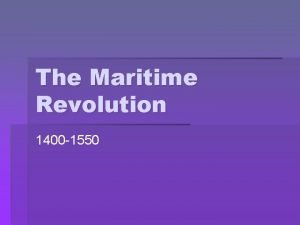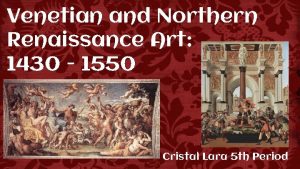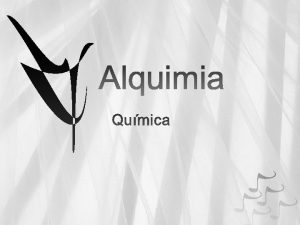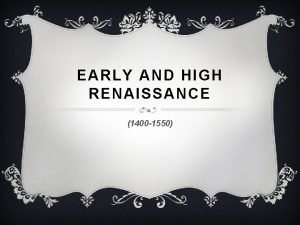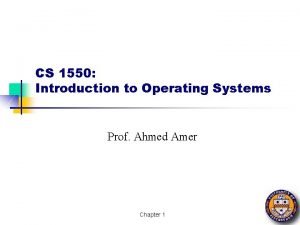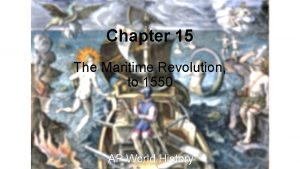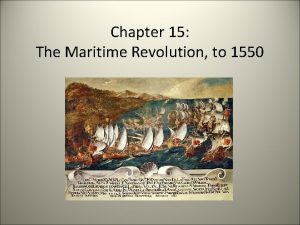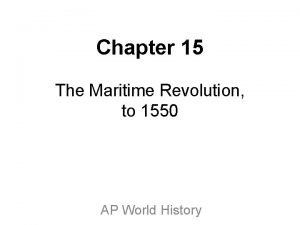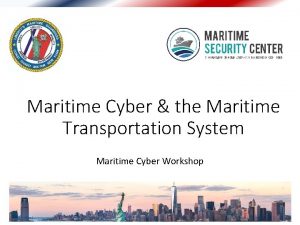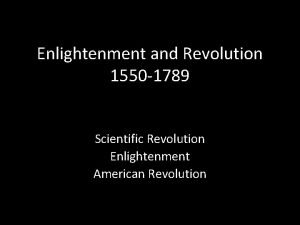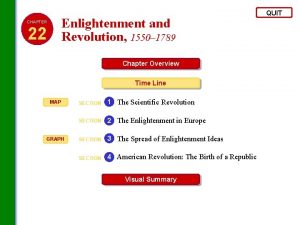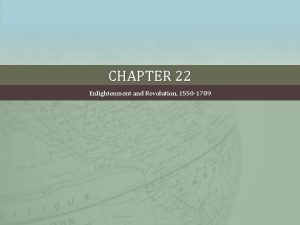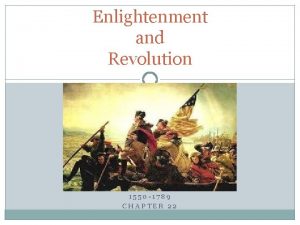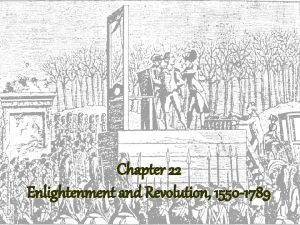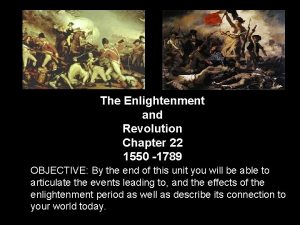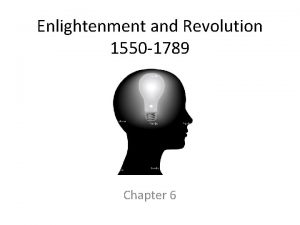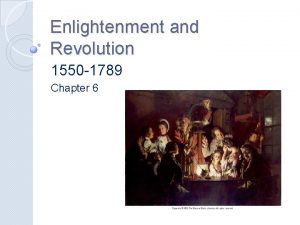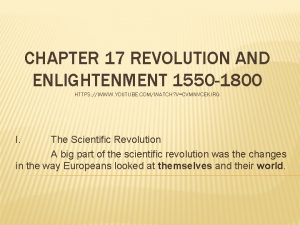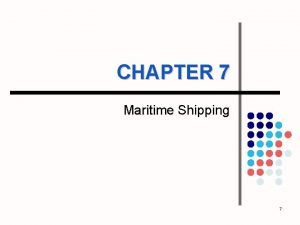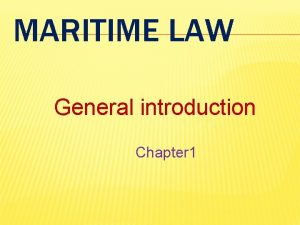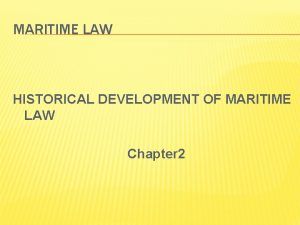Chapter 15 The Maritime Revolution to 1550 AP




















































- Slides: 52

Chapter 15 The Maritime Revolution, to 1550 AP World History

I. Global Maritime Expansion Before 1450 A. The Pacific Ocean • People from the Malay Peninsula crossed the water to settle the islands of the East Indies, New Guinea, the Melanesian and Polynesian islands, the Marquesas, New Zealand, and other Pacific islands out to Hawaii. • Voyages were planned with the intention of establishing colonies. • Navigated by stars and by observations of ocean currents and evidence of land.

Malay explorers were the first to explore the islands of the Pacific, which is the largest of the Earth’s oceanic divisions. (64. 1 million square miles)

Depiction of Malay mariners’ sailing canoes. A platform connected two canoes to make more room for the mariners and supplies.

B. The Indian Ocean • Arab seafarers used the regular pattern of the monsoon winds to establish trade routes. • Chinese Ming Dynasty sponsored voyages and were involved in a grand scale with fleets of over sixty treasure ships and hundreds of support vessels. • They carried out trade in luxury goods including silk and precious metals as well as stimulating diplomatic relations with various African and Asian states.

Indian Ocean maritime system.

Ming China exploration routes.

Superior sail, hull, and rudder technology made Chinese junks the most seaworthy vessel of their time. They sailed from India to southeast Asia on monsoon winds.

C. The Atlantic Ocean • The Vikings guided by stars and the seas explored Iceland, Greenland, and Newfoundland. • Voyagers from Genoa and Mali attempted to explore the Atlantic, but were never heard from again. • Genoese and Portuguese explorers discovered and settled the Madeiras, Azores, and the Canaries. • The Arawak from South America colonized the Lesser and Greater Antilles and the Carib followed.

Viking areas of exploration from Scandinavia to Newfoundland, the Mediterranean, Caspian and Black Seas.

Vikings had slender, flexible boats, with symmetrical ends and overlapping planks riveted together. They were able to navigate the rough seas of the North Atlantic as well as rivers that other navy's ships could not negotiate.

II. European Expansion, 1400 - 1550 A. Motives for Exploration • The Iberian kingdoms sponsored voyages for the following reasons; leaders, revival trade, struggle with Islam, curiosity, and alliances between rulers and merchants. • The city states of Italy had no incentive to explore Atlantic trade routes because they had a monopoly on access to Asian goods. • The Iberian kingdoms had a history of warfare with the Muslims, but they had no share of Mediterranean Sea trade. • They had advanced shipbuilding and cannon technology and were open to new geographical knowledge and had exceptional leaders.

Both the Spanish and Portuguese had a strong economic, religious, and political motives to explore. Improvements in maritime and military technology allowed them to master unknown bodies of water.

The various kingdoms within the Iberian peninsula. In 1492, the fall of Granada was the final Muslim stronghold that enabled the unification of the Spanish and Portuguese kingdoms.

Before the age of European maritime exploration, Europeans limited their voyages to the coastal areas in and around the Mediterranean.

B. Portuguese Voyages • Prince Henry conquered Cueta then sponsored a research and navigation institute at Sangres to collect information about and send expeditions to the African lands south of North Africa. • At Sangres the staff studied and improved the compass and the astrolabe, and designed the caravel. • Portuguese explorers learned to pick up prevailing western winds that would blow them back to Portugal.

• Voyages were initially financed by income from the properties held by Prince Henry’s Order of Christ • The voyages began to produce a financial return from the slave trade and then the gold trade. • Fernao Gomes sent expeditions that discovered and developed the island of Sao Tome, • Bartolomeu Dias reached the tip of Africa, but Vasco da Gama rounded the tip of Africa and established contact with India, thus laying the basis for Portugal’s maritime trading empire.

Henry the Navigator was a Portuguese prince and not a sailor himself. He sponsored a staff at Sangres to study and improve the compass, the astrolabe, and design the caravel.

Initial area of Portuguese exploration of the islands off North Africa under Henry the Navigator.

Henry the Navigator’s school for navigators and map-makers at Sangres located in southwest Portugal (1416).

A caravel is a small, highly maneuverable fighting ship with lateen sails that gave her speed and the capacity for sailing into the wind.

In 1469 Fernão Gomes explored 350 miles of African coast. He set up a trade monopoly while exploring the Gold Coast which became the headquarters for Portugal’s West African trade.

In 1488, Bartolomeu Dias was a Portuguese explorer and the first known European to have sailed around the southernmost tip of Africa.

Vasco da Gama was one of the most successful maritime explorers. In 1497 - 1498, he commanded the first ships to sail directly from Europe to India.

Vasco da Gama’s route from Europe to India.

C. Spanish Voyages • Christopher Columbus went to find a new route to Asia. • After four voyages, Columbus was still certain he had found Asia, but other Europeans realized he had discovered new lands. • Led Spain and Portugal to sign the Treaty of Tordesillas. • Ferdinand Magellan’s voyage across the Pacific confirmed Portugal’s claim to the Molucca Islands and established the Spanish claim to the Philippines.

Christopher Columbus was a Genoese mariner that led four Pacific voyages between 1492 and 1502. Until his death, he believed he had found a shorter route to the Indian Ocean the Portuguese.

Replica of the Pinta.

Christopher Columbus’s routes – Yellow: 1 st voyage (1492) Santa Maria sinks, Orange: 2 nd voyage (1493) 17 ships and 1, 200 men to colonize, Red: 3 rd voyage (1498) 6 ships but he returns in chains, Purple: 4 th voyage (1502 – 1504) sought Malacca with 4 old ships which left him stranded for a year.

The 1494 Treaty of Tordesillas divided the world between Portugal and Spain which was half way between Cape Verde and the Islands discovered by Columbus.

Ferdinand Magellan’s expedition of 1519 - 1522 was the first to sail from the Atlantic to the Pacific and was also the first circumnavigation of the Earth. Magellan himself was killed in the Philippines and of the 237 men who set out on the five ships, only 18 completed the circumnavigation.

The route of Ferdinand Magellan’s expedition (1519 - 1522)

III. Encounters with Europe, 1450 -1550 A. Western Africa • In return for gold Africans received firearms and a variety of Asian, African, and European goods. • The Oba of the powerful kingdom of Benin established a royal monopoly on trade with the Portuguese and showed a mild interest in Christianity. • The kingdom of Kongo had fewer goods to export and relied more on the slave trade.

In 1485, Portuguese explorers were the first Europeans to reach Benin. A strong mercantile relationship developed; they traded tropical products such as ivory, peppers and palm oil for manila and guns.

Benin Oba Ivory mask.

Congo, lacking ivory and pepper, sold more slaves which led to a black market. After 1540, the major part of the slave trade from this part of Africa moved farther south.

B. Eastern Africa • On the Swahili Coast, Malindi befriended the Portuguese and was spared when the Portuguese attacked and looted many of the other Swahili citystates in 1505. • Christian Ethiopia sought and gained Portuguese support in its war against the Muslim forces of Adal. • The Muslims were defeated, but a long term alliance fell through because Ethiopia refused to transfer their religious loyalty from the patriarch of Alexandria to the Roman Pope.

In 1539, Christian Ethiopia sought and gained Portuguese support in its war against the Muslim forces of Adal.

In 1539, a long-term alliance between Ethiopia and Portugal fell through because Ethiopia refused to transfer their religious loyalty from the patriarch of Alexandria, Jeremias I, to the Roman Pope, Paul III.

C. Indian Ocean States • Vasco da Gama made a poor impression, but the Portuguese superior ships and firepower gave them the ability to control Indian Ocean trade. • Using their superior military technology, the Portuguese conquered the Indian port of Goa, Hormuz, Malacca, and Macao in southern China. • They used these ports to collect taxes and make sure all goods were transported on Portuguese ships. • The Mughal emperors took no action, but the Ottomans resisted and were able to maintain superiority in the Red Sea and Persian Gulf. • The Portuguese never maintained complete control of the Indian Ocean trade, but they did dominate it enough to bring themselves considerable profit and to break the Italian city-states’ monopoly on pepper.

The Portuguese empire of the 16 th century.

The carrack was a three or four-masted sailing ship. Despite the Portuguese never gaining complete control of the Indian Ocean trade, their superior ships and weapons allowed them to dominate key ports and trade routes during the 16 th century.

Portugal had little impact on the Asian and African mainlands, in sharp contrast to what was occurring in the Americas.

D. The Americas • The Spanish built a territorial empire in the Americas. • The Spanish killed thousands of the Arawak, undermined their economy, forced the rest to serve as laborers, and took over their gold mines. • In the Antilles the Spanish put the land under Spanish control. • Hernan Cortes relied on native allies, cavalry charges, steel swords, and cannon to defeat the Aztec Empire and capture Tenochtitlan. – The conquest was also aided by the spread of smallpox. • Francisco Pizzaro used similar tactics to defeat the Inca Empire.

The areas of the world that at one time were territories of the Spanish and Portuguese Empires.

Hernán Cortés was a 16 th century Spanish conquistador who brought large portions of mainland Mexico under Spanish rule, including the Aztecs and their emperor, Moctezuma II.

In 1520, an Aztec rebellion against the Conquistadors left Moctezuma II killed and in the following year the capture of Tenochtitlan was facilitated by the spread of smallpox.

Smallpox localizes in small blood vessels of the skin and in the mouth and throat. In the skin, this results in a rash and later, raised fluid-filled blisters. Some estimates indicate fatality rates of 80 - 90% in Native American populations during smallpox epidemics.

Francisco Pizarro was a Spanish conquistador, conqueror of the Incan Empire and founder of Lima, the modern-day capital of Peru.

Francisco Pizarro and his conquistadors set out to conquer the Incas with a force of 180 men, 37 horses, and two cannons.

IV. Comparative Perspectives A. Imperial Comparisons • Strong centralized governments like China were not inclined to attempt long distance exploration. • Weaker rulers such as the Iberian monarchs left the details of exploration to individuals such as Columbus. • Dominance of the Americas by Spain and Portugal was aided by the native populations’ vulnerability to European disease and by the superior weaponry of Europe. • Natives of Asia and Africa had more immunity to European diseases from earlier contact and were able to resist militarily.

B. Economic Comparisons • Europeans found sophisticated markets and trade networks in Africa and Asia. • In contrast, Europeans needed to introduce new technology and strong political control over American natives to exploit their natural resources.
 Maritime revolution
Maritime revolution Venetian and northern renaissance (1430–1550)
Venetian and northern renaissance (1430–1550) Tlm 1550
Tlm 1550 Alquimia 300 a de c a 1500 despues de c
Alquimia 300 a de c a 1500 despues de c Renaissance art vocabulary
Renaissance art vocabulary Cs 1550
Cs 1550 Russian revolution vs french revolution
Russian revolution vs french revolution Did american revolution cause french revolution
Did american revolution cause french revolution Green revolution vs third agricultural revolution
Green revolution vs third agricultural revolution Hát kết hợp bộ gõ cơ thể
Hát kết hợp bộ gõ cơ thể Frameset trong html5
Frameset trong html5 Bổ thể
Bổ thể Tỉ lệ cơ thể trẻ em
Tỉ lệ cơ thể trẻ em Voi kéo gỗ như thế nào
Voi kéo gỗ như thế nào Tư thế worm breton
Tư thế worm breton Bài hát chúa yêu trần thế alleluia
Bài hát chúa yêu trần thế alleluia Các môn thể thao bắt đầu bằng từ đua
Các môn thể thao bắt đầu bằng từ đua Thế nào là hệ số cao nhất
Thế nào là hệ số cao nhất Các châu lục và đại dương trên thế giới
Các châu lục và đại dương trên thế giới Cong thức tính động năng
Cong thức tính động năng Trời xanh đây là của chúng ta thể thơ
Trời xanh đây là của chúng ta thể thơ Cách giải mật thư tọa độ
Cách giải mật thư tọa độ Phép trừ bù
Phép trừ bù độ dài liên kết
độ dài liên kết Các châu lục và đại dương trên thế giới
Các châu lục và đại dương trên thế giới Thơ thất ngôn tứ tuyệt đường luật
Thơ thất ngôn tứ tuyệt đường luật Quá trình desamine hóa có thể tạo ra
Quá trình desamine hóa có thể tạo ra Một số thể thơ truyền thống
Một số thể thơ truyền thống Cái miệng bé xinh thế chỉ nói điều hay thôi
Cái miệng bé xinh thế chỉ nói điều hay thôi Vẽ hình chiếu vuông góc của vật thể sau
Vẽ hình chiếu vuông góc của vật thể sau Thế nào là sự mỏi cơ
Thế nào là sự mỏi cơ đặc điểm cơ thể của người tối cổ
đặc điểm cơ thể của người tối cổ Thứ tự các dấu thăng giáng ở hóa biểu
Thứ tự các dấu thăng giáng ở hóa biểu Vẽ hình chiếu đứng bằng cạnh của vật thể
Vẽ hình chiếu đứng bằng cạnh của vật thể Vẽ hình chiếu vuông góc của vật thể sau
Vẽ hình chiếu vuông góc của vật thể sau Thẻ vin
Thẻ vin đại từ thay thế
đại từ thay thế điện thế nghỉ
điện thế nghỉ Tư thế ngồi viết
Tư thế ngồi viết Diễn thế sinh thái là
Diễn thế sinh thái là Dạng đột biến một nhiễm là
Dạng đột biến một nhiễm là Bảng số nguyên tố
Bảng số nguyên tố Tư thế ngồi viết
Tư thế ngồi viết Lời thề hippocrates
Lời thề hippocrates Thiếu nhi thế giới liên hoan
Thiếu nhi thế giới liên hoan ưu thế lai là gì
ưu thế lai là gì Sự nuôi và dạy con của hổ
Sự nuôi và dạy con của hổ Sự nuôi và dạy con của hươu
Sự nuôi và dạy con của hươu Hệ hô hấp
Hệ hô hấp Từ ngữ thể hiện lòng nhân hậu
Từ ngữ thể hiện lòng nhân hậu Thế nào là mạng điện lắp đặt kiểu nổi
Thế nào là mạng điện lắp đặt kiểu nổi University of split faculty of maritime studies
University of split faculty of maritime studies Sea vision vessel
Sea vision vessel
